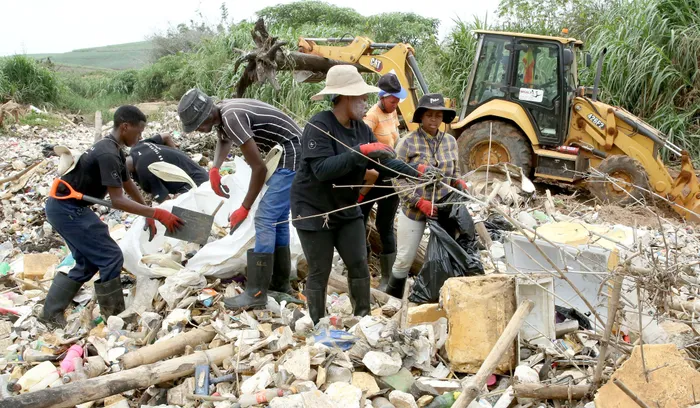Heavy rains a blessing and a pollution curse

Workers clear litter lodged inland that came barrelling down the Ohlanga River during recent rains and bottle-necked just short of the lagoon. Shelley Kjonstad/ANA
Heavy rains have been both a blessing and a curse.
Dams have filled, ensuring water “well into the winter months and beyond” but tons of litter have washed down watercourses and into the ocean.
Yesterday, river cleaners rushed to the Ohlanga River before the expected stormy weather, to remove a massive amount of litter in danger of being washed into the ocean.

It had bottlenecked about a kilometre upstream of the confluence of the stream that, six months ago, brought down toxic chemicals from the warehouse looters burnt, causing a spillage that is still being cleaned up.
Josh Redman, a director of the non-profit environmental organisation Litterboom, which collects plastic waste for recycling, said the donation of a mechanical loader yesterday, along with R150 000 from businesses had been a godsend. Until then, workers had used pitchforks and spades to clear the trash.


He said the challenge was bigger than his organisation could cope with.
“It’s been ongoing since Monday and nobody has been to help us. We’ve had a lot of support from community and small industry that have made donations and we have brought on a good 20 staff but there has been no municipality, or other organisations, coming to give us a hand, so, at this point, we’re plugging away. We are not waiting for anyone to come. We are just going for it.”

Yesterday, 11 of the 15 dams managed by Umgeni Water continued to over flow.
“For the first time in seven years, Albert Falls – the largest dam in KwaZulu-Natal – exceeded 80%, after gaining 15% in a week,” said spokesperson Shami Harichunder.
“Eleven of them continued to overflow.”
Harichunder said the total collective raw water storage in the Mgeni System stood at 96%.


“It is estimated that there is sufficient water available to last another 15 months, well into the winter months and beyond.
“Hazelmere Dam, outside Verulam, has also been a beneficiary of good rains over the past two weeks.”
Steve McCurrach, who took aerial photographs of Howick Falls and Karkloof Falls “pumping”, said the many years of Albert Falls being less than 50% full should be about to change.
“We can assume that when Albert Falls does overflow, this uninterrupted flow will reach Inanda, which is already overflowing, and the entire chain of Mgeni River dams will be 'over the wall' and flowing freely. This will make a decades-long awaited, marvellous and healthy ‘flushing’ event on the Mgeni.”
Harichunder confirmed that Albert Falls Dam was 83.7% capacity on January 14.
“A year ago, on January 15 , it was at 34, 66%.”
Nagle Dam was at 93, 56%.
Litterboom’s Redman said that when the dust settled, a thorough investigation needed to be carried out to establish where and why litter ended up where it could be flushed down rivers and into the ocean.
He stressed the need for educational projects that had follow-ups to encourage communities to properly deal with litter. He noted that there was economic value in recycling and much of the present problem litter had been taken for that processing.
“We have taken six to eight truckloads, each of about 200kg, to recycling. We don’t want it to go back to landfill but now it’s got to the point where it will just take too much time to sift through, so we’ve got to cut our losses and just get it out of the river (and take it to landfill sites).”
Redman said the same problem occurred after heavy rains three years ago at the same spot.
“We and other organisations did a clean up and installed a boom to catch litter. Now, three years of build-up finally flushed out but we can’t wait another three years for it to happen again.
“We have to start working closer to the source and alleviate that pressure.”
eThekwini Municipality spokesperson Msawakhe Mayisela said the city appreciated such good citizenship, but the city “could not do everything alone; citizens have a responsibility too. Ridding our rivers of litter is everyone’s responsibility”.
“Journalists also have the responsibility to educate the public in this regard to augment the efforts of the government,” he said, adding that the government sent out messages urging everyone to keep the environment clean.
uShaka Sea World education executive manager Jone Porter said the litter was "a small percentage“ of the problem.
“The real issue is the day-to-day accumulation of litter. It’s coming all the time. When there is heavy rain, we notice it. Otherwise it is out of sight and out of mind.”
She said it was important to remember that marine animals did not have hands, “so they investigate using their mouths, whether they are crabs, dolphins, whatever”, making them more vulnerable to consuming plastic.
“Big litter is not as dangerous as little litter that has often broken down, so it’s important to clear the big litter off the beaches, so it doesn’t have a chance to break into thousands of pieces.“
Porter said the small circle of plastic attached to a cooldrink bottle top could easily go over a bird’s beak or a crab’s legs and get stuck.
“Cut them before they go into the bin. The same with the elastic on a mask and the strapping that comes around boxes of paper.”
Janet Simpkins, of Adopt a River, said that since January 3, 47 one-ton bags of litter had been taken from the Mgeni River.
She described the problem of pollution lodged in the ground inland as “the tragedy of the tributaries”.
The Independent on Saturday
Related Topics: